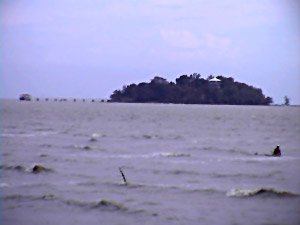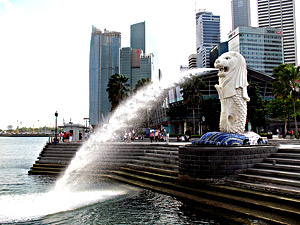 Territorial history of Indian Ocean when counted within the boundaries of Indian government, very much can be assimilated amidst the vast Indian history. India takes in the major portion of Indian Ocean within its territory, leading to many prosperous Western civilisations garnering interest in this Oriental country. Millennia before Christopher Columbus sailed the Atlantic, the Indian Ocean was a highway for commerce and cultural exchanges between nations as far away as China in the East and the Mediterranean and Europe in the west. The cities of Babylon and Nineveh had trade relations with the West coast of India and King Solomon sent ships in search of riches in the East. Some of the archaeological discoveries at Mohenjodaro of the period 3000 to 2500 B.C. show many artefacts that could only have come from the Red Sea area. The oldest `dated` evidence of maritime activity is of the period 1500 B.C., in a sloka (Sanskrit verse) from the Rig Veda.
Territorial history of Indian Ocean when counted within the boundaries of Indian government, very much can be assimilated amidst the vast Indian history. India takes in the major portion of Indian Ocean within its territory, leading to many prosperous Western civilisations garnering interest in this Oriental country. Millennia before Christopher Columbus sailed the Atlantic, the Indian Ocean was a highway for commerce and cultural exchanges between nations as far away as China in the East and the Mediterranean and Europe in the west. The cities of Babylon and Nineveh had trade relations with the West coast of India and King Solomon sent ships in search of riches in the East. Some of the archaeological discoveries at Mohenjodaro of the period 3000 to 2500 B.C. show many artefacts that could only have come from the Red Sea area. The oldest `dated` evidence of maritime activity is of the period 1500 B.C., in a sloka (Sanskrit verse) from the Rig Veda.
Territorial history of Indian Ocean also bears irrefutable evidence of navigation in the Bay of Bengal and Indian Ocean, prior to the Christian era. As early as fourth century B.C., emperors had a coordinated system of port administration for the harbours all along the East coast and for shipping services between them and the countries of Southeast Asia. Later, during the first century A.D., the Andhra dynasty that followed the Mauryas, the Satavahanas (called the "Lords of the three Oceans"), boosted overseas colonisation and trade. Over the next few decades, parts of Malaya, Sumatra, Java, Annam (southern Thailand) and some islands in the Pacific were under the sway of Hindu culture.
Between fifth century B.C. and sixth century A.D., the Mauryas, the Andhras, the Cholas Pandyas and Pallavas maintained maritime supremacy in the Bay of Bengal. Rajaraja Chola in fact extended Chola domination to every corner of south India and also Sri Lanka. His son and successor is believed to have conquered the Andaman and Nicobar Islands during his advance to the Ganges River and Bengal. Territorial history of Indian Ocean was grandly being rewritten under powerful Hindu rulers, striving to take India into an oriental excellence. Till about the thirteenth century powerful Indian maritime forces existed, which enabled development and bountiful spread of Indian trade capability. Such potential maritime forces also utilised for attacks and conquests, where necessary, in the Southeast Asian region. Generally during this period, the Malabar rulers controlled the Eastern region of the Arabian Sea.
 India, during those bygone centuries was a vast country, with every mighty ruler aiming to conquer countries across the Indian Ocean. This had led to exchange of overseas cultural activities, altering the territorial history of Indian Ocean, including the country itself. From approximately the seventh century to thirteenth century, the Sri Vijaya Empire (a Hindu empire) based in Sumatra, held command of the Malacca Straits. This empire expanded to parts of Malaya, Java and other islands in the region. Control of the Malacca strait conferred on the Sri Vijaya Empire the ability to dominate trade through the straits. Shipping, utilising the straits was required to call at the capital and the maritime administration regulated traffic through the lanes. Historians are also of the view that it was Sri Vijaya Empire followed by the Majapahit Empire up to the end of the fifteenth century that prevented the Chinese from dominating Southeast Asia.
India, during those bygone centuries was a vast country, with every mighty ruler aiming to conquer countries across the Indian Ocean. This had led to exchange of overseas cultural activities, altering the territorial history of Indian Ocean, including the country itself. From approximately the seventh century to thirteenth century, the Sri Vijaya Empire (a Hindu empire) based in Sumatra, held command of the Malacca Straits. This empire expanded to parts of Malaya, Java and other islands in the region. Control of the Malacca strait conferred on the Sri Vijaya Empire the ability to dominate trade through the straits. Shipping, utilising the straits was required to call at the capital and the maritime administration regulated traffic through the lanes. Historians are also of the view that it was Sri Vijaya Empire followed by the Majapahit Empire up to the end of the fifteenth century that prevented the Chinese from dominating Southeast Asia.
Up to the beginning of the eleventh century, relations between the Chola dynasty and the Sri Vijaya Empire were cordial. However commercial dominance and exclusivity practiced by Sri Vijaya Empire as also their enforcing of high tariffs prompted the Cholas to attack the Sri Vijaya Empire in 1025 A.D. and for a second time a few years later. The Chola emperor of the eleventh century, Rajendra Chola, had developed a potential navy, with which he thwarted the forces of Sri Vijaya Empire. Territorial history alongside Indian Ocean went tumultuous after such on and off assaults by mighty empires, projecting to ascend to the throne. The commercial monopoly was thus broken. By the end of the 11th century both the Hindu sea powers, the Cholas on the mainland of India and the Sri Vijaya`s maritime empire based in Southeast Asia were considerably weakened by continuous warfare, which deeply affected trade capability. The weakness of the two Hindu kingdoms also paved way for the establishment of Muslim supremacy in Indian waters during the thirteenth century, thus ending the Golden Period of Indian maritime history.
Till the thirteenth century, India expanded, commanded and controlled trade and Naval capabilities in the Indian Ocean including freedom of navigation in the Arabian Sea, the command of Malacca strait and, as a result, expansion of trade with China. Territorial history of Indian Ocean was thus once again being altered in its course, with gradual advent of Islamic rule through high seas. Both the Arabs and Chinese crossed the Indian Ocean to trade with each other and it was the Arabs who derived benefit as intermediaries of trade between India and Europe. With the downfall of the Sri Vijaya Empire and Majapahit Empire and the decline of the Cholas, this trade passed entirely into the hands of the Arabs. Hence, Indian dominance over the Malacca straits was completely lost.
Territorial history of Indian Ocean was elevated in its prestige after maiden European voyages, crossing the Atlantic and Pacific. The first successful European attempt to reach India via the Cape of Good Hope was made toward the close of the fifteenth century, when Vasco da Gama reached Calicut (present day Kozhikode) in May 1498. Ever since, contest for possession and control of the seas around India began to be waged, almost continuously, throughout the sixteenth, seventeenth, and eighteenth centuries, until England established supremacy. This occurred after British victory over the French at Trafalgar in 1805 and they pulled off to make Indian Ocean a `British Lake`. Subsequently, for a period of a century and a half, until 1941 when Japanese sea power extended into the Indian Ocean after some quick victories in the Pacific and South China Sea, Britain was supreme in the Indian Ocean. Post the two World Wars, Japanese attack and Indian Independence, British policy makers decided to withdraw from East of Suez by 1969 and offered an opportunity to India to restore her lost glory in Indian Ocean.






































